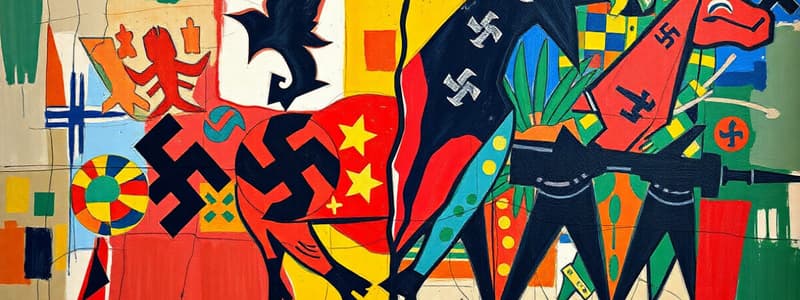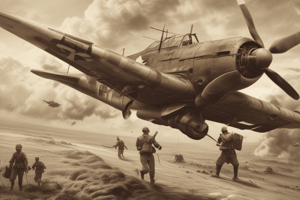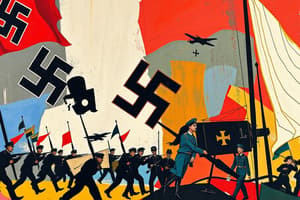Podcast
Questions and Answers
Which of the following countries was NOT a member of the Axis Powers?
Which of the following countries was NOT a member of the Axis Powers?
- Germany
- Japan
- Italy
- France (correct)
In what year did Adolf Hitler become Chancellor of Germany?
In what year did Adolf Hitler become Chancellor of Germany?
1933
What was the name of the treaty that formed the Rome-Berlin Axis?
What was the name of the treaty that formed the Rome-Berlin Axis?
The Rome-Berlin Axis Treaty
What was the name of the agreement signed by Germany, Italy, and Japan that formalized their alliance?
What was the name of the agreement signed by Germany, Italy, and Japan that formalized their alliance?
The Anti-Comintern Pact was primarily aimed at combating communism and Russia.
The Anti-Comintern Pact was primarily aimed at combating communism and Russia.
What was the name of the German military tactic used in the early stages of World War II?
What was the name of the German military tactic used in the early stages of World War II?
Who became the leader of the British government in 1940?
Who became the leader of the British government in 1940?
What was the name of the genocide orchestrated by the Nazi regime during World War II?
What was the name of the genocide orchestrated by the Nazi regime during World War II?
What was the name of the laws implemented by the Nazis in 1935 that stripped Jews of their rights and citizenship?
What was the name of the laws implemented by the Nazis in 1935 that stripped Jews of their rights and citizenship?
What was the name of the major battle that occurred in the air over Great Britain in 1940?
What was the name of the major battle that occurred in the air over Great Britain in 1940?
What was the name of the Japanese attack on the US Navy that occurred on December 7, 1941?
What was the name of the Japanese attack on the US Navy that occurred on December 7, 1941?
The Allies invaded and took the island of Sicily in 1943.
The Allies invaded and took the island of Sicily in 1943.
The Germans launched a large attack in the Battle of Bulge in early 1944.
The Germans launched a large attack in the Battle of Bulge in early 1944.
In what year did Adolf Hitler commit suicide?
In what year did Adolf Hitler commit suicide?
What was the name of the international agreement that officially ended World War II?
What was the name of the international agreement that officially ended World War II?
The bombing and fighting during World War II caused significant destruction in Europe and Asia.
The bombing and fighting during World War II caused significant destruction in Europe and Asia.
Who was the leader of the United States during World War II?
Who was the leader of the United States during World War II?
Who was the leader of Great Britain during World War II?
Who was the leader of Great Britain during World War II?
Who was the leader of Russia during World War II?
Who was the leader of Russia during World War II?
Flashcards
Adolf Hitler
Adolf Hitler
The leader of the Nazi Party and Germany during World War II.
Nazism
Nazism
A political ideology that emphasizes nationalism, racial purity, and authoritarian leadership. Key features include strong militarism, expansionism, and anti-Semitism.
Fascism
Fascism
A political ideology that emphasizes the importance of the nation-state and its people over individual rights.
Axis Powers
Axis Powers
Signup and view all the flashcards
Blitzkrieg
Blitzkrieg
Signup and view all the flashcards
September 1, 1939
September 1, 1939
Signup and view all the flashcards
Allied Powers
Allied Powers
Signup and view all the flashcards
The Holocaust
The Holocaust
Signup and view all the flashcards
Nuremberg Laws
Nuremberg Laws
Signup and view all the flashcards
December 7, 1941
December 7, 1941
Signup and view all the flashcards
Battle of Midway
Battle of Midway
Signup and view all the flashcards
Invasion of Sicily
Invasion of Sicily
Signup and view all the flashcards
D-Day
D-Day
Signup and view all the flashcards
Battle of the Bulge
Battle of the Bulge
Signup and view all the flashcards
Iwo Jima
Iwo Jima
Signup and view all the flashcards
Crossing the Rhine River
Crossing the Rhine River
Signup and view all the flashcards
German Surrender
German Surrender
Signup and view all the flashcards
Atomic Bombing
Atomic Bombing
Signup and view all the flashcards
Winston Churchill
Winston Churchill
Signup and view all the flashcards
Joseph Stalin
Joseph Stalin
Signup and view all the flashcards
Franklin D. Roosevelt
Franklin D. Roosevelt
Signup and view all the flashcards
Benito Mussolini
Benito Mussolini
Signup and view all the flashcards
Emperor Hirohito
Emperor Hirohito
Signup and view all the flashcards
Treaty of Potsdam
Treaty of Potsdam
Signup and view all the flashcards
Operation Barbarossa
Operation Barbarossa
Signup and view all the flashcards
Pearl Harbor Attack
Pearl Harbor Attack
Signup and view all the flashcards
Battle of Britain
Battle of Britain
Signup and view all the flashcards
Terror
Terror
Signup and view all the flashcards
Ghettos
Ghettos
Signup and view all the flashcards
Concentration Camps
Concentration Camps
Signup and view all the flashcards
Extermination Camps
Extermination Camps
Signup and view all the flashcards
Study Notes
World War II (1939-1945)
-
Axis Powers: Germany, Italy, and Japan formed an alliance in 1936, later joined by other countries
-
Adolf Hitler: Became chancellor of Germany in 1933
-
Rome-Berlin Axis Treaty (1936): Alliance between Germany and Italy
-
Anti-Comintern Pact (1936): Agreement between Germany and Japan against communism
-
Japan invades China (1937): Led to further international tensions
-
Anschluss (1938): Germany annexed Austria
-
Germany invades Poland (1939): Marked the beginning of World War II
-
Blitzkrieg: Germany's military strategy of quick, coordinated attacks
-
Axis Powers Leaders:
-
Germany: Adolf Hitler
-
Italy: Benito Mussolini
-
Japan: Emperor Hirohito
-
Allied Powers: Major countries opposing the Axis, including Great Britain, the United States, and the Soviet Union
-
Holocaust: A genocide orchestrated by Nazi Germany targeting Jews, Roma (Gypsies), the disabled, Slavs, political dissidents, Jehovah's Witnesses and homosexuals.
-
Methods of persecution: forced labor, ghettos, concentration camps, mass shootings, gas chambers.
-
Estimated deaths: Approximately 6 million Jews and 11 million others were murdered
-
Nuremberg Laws (1935): Designed to strip Jews of their rights and citizenship
Timeline of Key Events
-
June 10, 1940: Germany launched air attacks on Great Britain (Battle of Britain)
-
June 22, 1941: Germany invaded the Soviet Union
-
December 7, 1941: Japan attacked Pearl Harbor, drawing the United States into the war
-
June 4, 1942: The US Navy defeated the Japanese at the Battle of Midway
-
July 10, 1943: Allied invasion of Sicily
-
September 3, 1943: Italy surrendered
-
June 6, 1944: Allied invasion of France
-
August 25, 1944: Liberation of Paris
-
December 16, 1944: German offensive (Battle of the Bulge)
-
February 19, 1945: US Marines took Iwo Jima
-
April 12, 1945: US President Franklin D. Roosevelt died
-
April 30, 1945: Adolf Hitler committed suicide
-
May 7, 1945: Germany surrendered
-
August 6, 1945: US dropped atomic bomb on Hiroshima
-
August 9, 1945: US dropped atomic bomb on Nagasaki
-
September 2, 1945: Japan surrendered.
-
Treaty of Potsdam (1945): Officially ended World War II
Studying That Suits You
Use AI to generate personalized quizzes and flashcards to suit your learning preferences.




